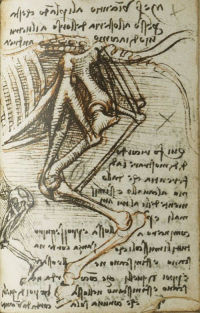The Natural World Click on the thumbnails to explore the trail
Read more about this trail (expand)
Leonardo’s endless curiosity regarding the form and function of all natural phenomena is attested to in his drawings, manuscripts and paintings. As nature could only be understood by direct “experience” or engagement with real life models, man, plants, animals, and the world that they inhabited became the subject of intense scrutiny in the quest for understanding of all natural things.
Paris Manuscript K (including K1, K2 and K3) 1503-1508
During the Renaissance, animals provided a more ready means of anatomical dissection than human remains. The bodily systems of cows, pigs and horses were seen to provide vital information that could be applied to understanding the physiology of man.
In this drawing, Leonardo embarks on a sort of comparative analysis, comparing the skeleton of a horse with that of a human. He does this in order to understand the skeletal structure and the movement of both human and animal. His anatomical investigations of the horse were an important means of understanding the form and structure of the animal, which was necessary in order to be able to recreate horses convincingly in either paintings or sculpture.
Leonardo pursued the task at length in his notebooks and in individual drawings. He did so in response to the requirements of commissions for sculpted monuments, such as the equestrian monuments for Francesco Sforza and Giangiacomo Trivulziano, and also for paintings such as the Adoration of the Magi and the Battle of Anghiari, which both included horses.
In Leonardo's words
Here I make a note to demonstrate the difference there is between the man and the horse, and in the same way with other animals…The walking of man is always after the universal manner of walking in animals with four legs, inasmuch as just as they move their feet cross-wise after the manner of a horse in trotting, so man moves his four limbs cross-wise; that is, if he puts forward his right foot in walking he puts forward with it his left arm, and vice versa…
Paris Mauscript K consists of three pocket-sized notebooks still in their original binding. The notes relate mainly to the study of Euclid’s geometry.
The notebooks count a total of 128 folios between them.
- Medium Pen and ink on paper
- Size 9.6 x 6.5 cm
- Location Bibliothèque de l’Institut de France











